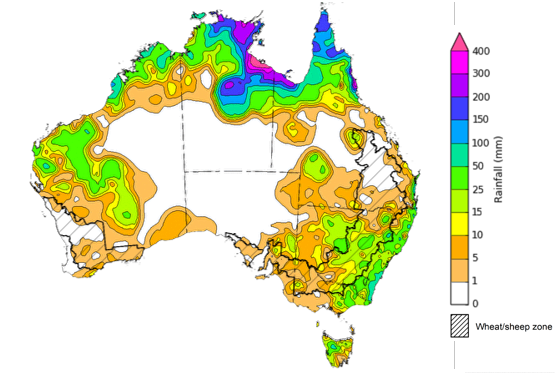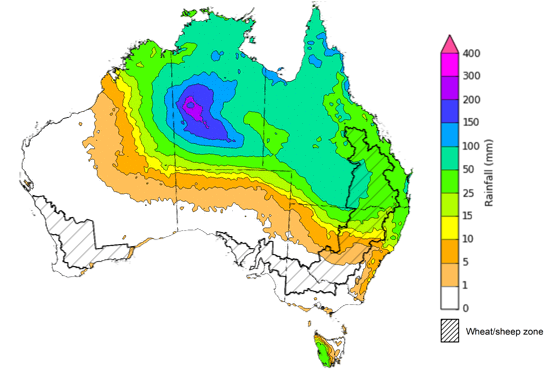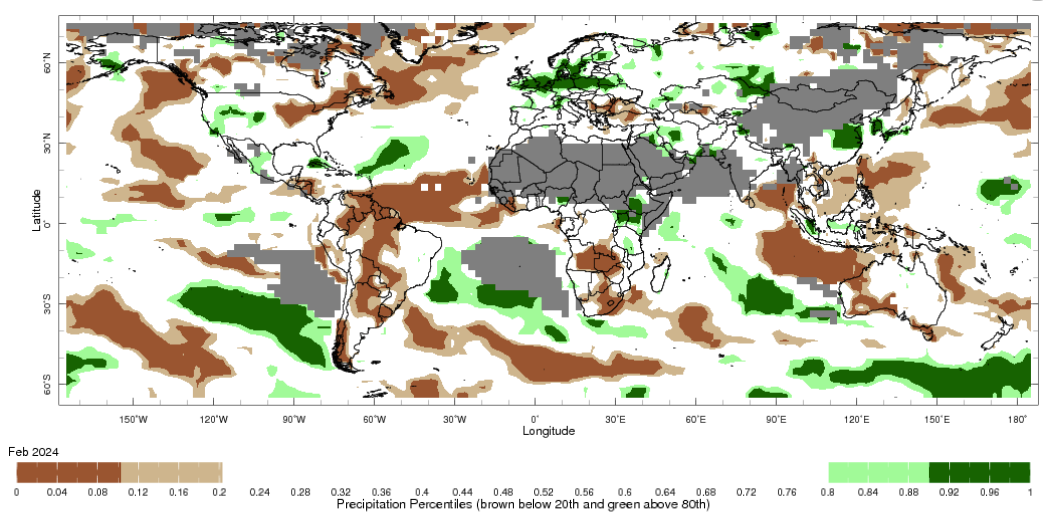Key issues
- In the week ending 20 March 2024, the monsoon lows generated rain and storms in the tropics extending to central Western Australia and far-north Queensland. Tropical Cyclone Megan generated higher than anticipated rainfall in the north, reaching 300 millimetres in some areas.
- Across cropping regions, New South Wales recorded up to 100 millimetres of rainfall, up to 25 millimetres in Victoria, South Australia and Northern Queensland. Minimal rainfall occurred in Western Australia cropping regions not exceeding 10 millimetres.
- Over the coming days, northern half of the country is expected to receive up to 300 millimetres of rainfall associated with low pressure systems.
- A wet week in Queensland and northern New South Wales cropping regions will likely interrupt harvest of summer crops but boost soil moisture levels for winter crops.
- Dry week in the remaining cropping regions will likely see a decline in soil moisture levels.
- Globally, variable rainfall during February has led to mixed crop production prospects.
- Global production conditions were generally favourable for rice while mixed for wheat, soybeans and maize.
- Global production conditions have generally remained largely unchanged, except for in South America, compared to those used to formulate ABARES forecasts of global grain supplies and world prices for 2023–24 in its March 2024 edition of the Agricultural Commodities Report. As a result, global grain and oilseed production are likely to remain similar those present on the March forecast, with falls in corn production to be offset by increase in rice and wheat production.
- Water storage levels in the Murray-Darling Basin (MDB) decreased between 14 March 2024 and 21 March 2024 by 166 gigalitres (GL). Current volume of water held in storage is 17 327 GL, equivalent to 78% of total storage capacity. This is 13 percent or 2539 GL less than at the same time last year.
- Allocation prices in the Victorian Murray below the Barmah Choke increased from $27 on 14 March 2024 to $30 on 21 March 2024. Prices are lower in the Murrumbidgee and regions above the Barmah choke due to the binding of the Murrumbidgee export limit and Barmah choke trade constraint.
Climate
For the week ending 20 March 2024, monsoon lows generated rain and storms in the tropics extending to central Western Australia and far-north Queensland. Tropical Cyclone Megan generated higher than anticipated rainfall around the Gulf of Carpentaria, reaching 300 millimetres in some areas.
A low-pressure trough resulted in showers and thunderstorms in New South Wales, south-east South Australia, and eastern Victoria. Meanwhile, a cold front in Tasmania brought rainfall exceeding 25 millimetres in some areas.
Across cropping regions, rainfall totals up to 50 millimetres were recorded across parts of New South Wales of, while up to 25 millimetres was recorded across scatted areas of Victoria, South Australia and Queensland. Minimal rainfall occurred in Western Australia cropping regions not exceeding 10 millimetres.
Minimal rainfall across much of Queensland allowed an uninterrupted harvest of summer crops. Rainfall across New South Wales will contribute to soil moisture storage for the winter cropping season.
Rainfall for the week ending 20 March 2024

Issued: 20/03/2024
Note: The rainfall analyses and associated maps utilise data contained in the Bureau of Meteorology climate database, the Australian Data Archive for Meteorology (ADAM). The analyses are initially produced automatically from real-time data with limited quality control. They are intended to provide a general overview of rainfall across Australia as quickly as possible after the observations are received. For further information go to http://www.bom.gov.au/climate/rainfall/
Over the 8 days to 28 March 2024, low pressure systems are expected to generate rainfall totals of up to 300 millimetres across most of the northern half of the country. High pressure systems will keep the southern half of the country generally dry. A cold front will result in rainfall in western Tasmania.
Across cropping regions, rainfall totals up to 100 millimetres are forecast for Queensland and up to 50 millimetres in northern New South Wales. If realised, these falls will boost soil moisture levels for pasture growth and prepare the season for the winter crops. However, the expected rainfall is likely to interrupt harvest of summer crops. Little to no rainfall is expected across the remaining cropping regions. With drier conditions in the recent weeks, particularly in South Australia and Victoria, soil moisture levels are likely to continue declining.
Total forecast rainfall for the period 21 March to 28 March 2024

Issued 21/03/2024
Note: This rainfall forecast is produced from computer models. As the model outputs are not altered by weather forecasters, it is important to check local forecasts and warnings issued by the Bureau of Meteorology.
Crop production is affected by long-term trends in average rainfall and temperature, interannual climate variability, shocks during specific growth stages, and extreme weather events. Some crops are more tolerant than others to certain types of stresses, and at each growth stage, different types of stresses affect each crop species in different ways.
The precipitation anomalies and outlooks presented here give an indication of the current and future state of production conditions for the major grain and oilseed producing countries which are responsible for over 80% of global production. This is an important input to assessing the global grain supply outlook.
February precipitation percentiles and current production conditions
As of the end of February 2024, rainfall was mixed for the world’s major grain-producing and oilseed-producing regions.
Precipitation was below average across large parts of southern hemisphere cropping regions. Precipitation was average to above average in the most of northern hemisphere grain and oilseed producing regions.
Global precipitation percentiles, February 2024

Source: International Research Institute for Climate and Society
As of 28 February 2024, global production conditions were generally favourable for rice, but variable for wheat, maize and soybeans. Winter wheat in the southern areas of the northern hemisphere begins to break winter dormancy. Maize conditions are mixed for Brazil, northern Argentina, South Africa, and Mexico. Rice conditions are generally favourable, albeit with some dry conditions in Thailand, the Philippines and southern India. Soybean conditions are mixed due to the impacts of earlier hot and dry weather in Brazil and northern Argentina.
Wheat: In the northern hemisphere, winter wheat begins to break winter dormancy in the southern regions under mixed conditions in parts of Europe, Ukraine, the Russian Federation, and north America.
Maize: In the southern hemisphere, harvesting of the spring-planted crop is continuing under mixed conditions in Brazil as conditions improve in Argentina. Dry conditions develop in South Africa.
Rice: In India, transplanting of the Rabi crop continues in the east. In Bangladesh, Boro season rice is favourable. In southeast Asia, conditions are favourable in Indonesia as dry conditions develop in Thailand and the Philippines.
Soybeans: In the southern hemisphere, harvesting is continuing in Brazil under mixed conditions as recent rainfall improves crops in Argentina.
Crop conditions, AMIS countries, 28 February 2024

Source: AMIS
The global climate outlook for April 2024 to June 2024 indicates that mixed rainfall conditions are expected for the world’s major grain-producing and oilseed-producing regions. Outlooks and potential production impacts for the major grain and oilseed producing countries are presented in the table.
| Region | April-June rainfall outlook | Potential impact on production |
|---|---|---|
| Argentina | Below average rainfall is more likely across western parts of Argentina between April and June 2024. Generally, average rainfall is likely in the eastern half of the country. | Average rainfall in the east is likely to be sufficient to support the development of sorghum, rice, millet, and the planting of wheat in May 2024. |
| Black Sea Region | Average to above average rainfall is likely for Ukraine, Türkiye and the Russian Federation. | Above average rainfall in Ukraine and Türkiye may support winter wheat and canola development, as well as cotton, corn and sunflower planting from March 2024. Average or above average rainfall across the Russian Federation is likely to support similar crops in the south and the planting and development of spring wheat planting in the north from April 2024. |
| Brazil | Below average rainfall is more likely across much of Brazil, with exceptions in the eastern areas where average to above average rainfall is likely. | Below average rainfall across southern and central western Brazil is likely to hinder the development of cotton and corn, and the harvesting of soybeans. Below average rainfall in the south is likely to hinder the development and harvesting of rice, sorghum, millet, sunflower, soybeans, cotton, nuts and corn, and the planting of wheat in May 2024. |
| Canada | Generally, average to above average rainfall is more likely across much of central and southern Canada between April and June 2024. | Average rainfall is likely to be sufficient to support winter wheat development in Canada from March 2023 and the planting of spring wheat, canola, corn, soybeans and sunflower from May 2023. |
| China | Average to above average rainfall is more likely across much of central and eastern China while below average rainfall is more likely across parts of southern China. | Average to above average rainfall across much China is likely to support the development of winter wheat and canola and the planting and development of early rice, single rice, cotton and spring wheat. Below average rainfall across southern China may affect the development of these crops from April 2024. |
| Europe | Average to above average rainfall is more likely for much of Europe between April and June 2024. | Average to above average rainfall across Europe is likely to support winter wheat and canola development and the planting and development of corn, cotton, spring wheat, April and June 2024. |
| South Asia (India) | Above average rainfall is more likely across much of southern India, while central India is likely to experience average rainfall. | Above average rainfall is likely to support the development of wheat and canola in India. |
| Southeast Asia (SEA) | Below average rainfall is likely across SEA. Above average rainfall is forecast for much of Indonesia. | Below average rainfall across most of Southeast Asia is likely to affect corn and rice planting, development and harvesting. Below average rainfall may adversely impact rice, corn and soybean production. Above average rainfall in Indonesia is likely to support the planting of spring wheat and rice. |
| The United States of America (US) | Average to above average rainfall is more likely for eastern half of US while below average to average rainfall is more likely in the isolated parts in the west. | Average or better rainfall in the US is likely to support winter wheat as it comes out of dormancy, as well as the planting and development of spring wheat, canola, corn, cotton, and rice. |
Water
Water storages, water markets and water allocations - current week
The Tableau dashboard may not meet accessibility requirements. For information about the contents of these dashboards contact ABARES.
Commodities
Information on weekly price changes in agricultural commodities is now available at the Weekly commodity price update.
